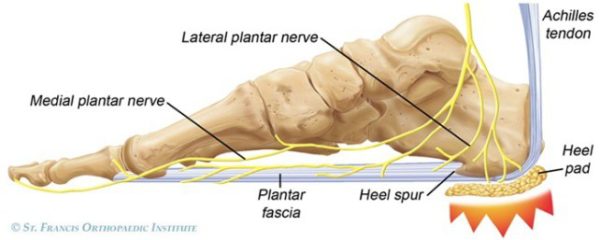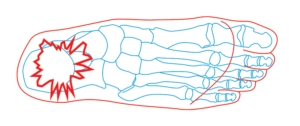How To Treat A Bruised Heel Bone
Bruised Heel (Fat Pad Contusion)
By Terry Zeigler, EdD, ATC
Sports participation tin can place the foot at risk for a number of injuries including a bruised heel or Fat Pad Contusion. Because the calcaneus is the largest bone in the foot and the primary weight-bearing bone, it is subject field to injury. Although ankle sprains are the most common ankle/foot injury, a heel bruise can be quite debilitating.
A heel bruise tin can exist a painful injury and can be the event of either ane acute injury or from repetitive impact on the foot. Although moderate injuries can result in a contusion to the fatty pad surrounding the calcaneus or a deep os bruise, repetitive injuries tin result in a calcaneal stress fracture.
What is a hobbling heel?
The calcaneus is the os in the pes that bears nigh of the weight during the heel strike phase of an athlete's frontward motion. The weight of the athlete is transferred from the tibia through the talus (smaller tarsal os) and to the calcaneus during heel strike before the athlete's weight is transferred through the other small tarsal bones on through the metatarsals and out through the toes.
The calcaneus is at risk for injury considering it is the sole bone that makes initial contact with the ground when the athlete walks, jogs, or lands from a jump. Surrounding the calcaneus is elastic adipose (fatty) tissue for the purpose of cushioning and protecting the calcaneus from affect injuries.
Regardless of the crusade, the outcome to the athlete is bruising on the bottom of the heel that and feels like pain directly at the bottom of the heel.
What is the nomenclature of heel injuries?
A heel injury can include a range of injuries from balmy (bruise) to moderate (stress fracture or os bruise) to severe (fracture of the calcaneus). The severity of the injury depends on the amount of force placed on the calcaneus.
An injury resulting in a heel bruise may result in pain during walking or weight bearing, swelling in and around the heel, and tenderness of the heel to pressure. Injury to the heel pad might also effect in displacement of the heel pad laterally and medially (to either side) resulting in a flat spot nether the calcaneus compared to the uninjured foot. If the athlete continues to work out on a bruised heel, the injury may develop into chronic inflammation of the periosteum (outside perimeter of the os) a much more than debilitating injury.
Calcaneal stress fractures have been associated with excessive marching (as in the military) on hard surfaces in boots without quality shock absorption or in long distance runners. Besides calcaneal stress fractures, other bones that have a higher run a risk for a stress fracture in the human foot include the navicular, the metatarsals, and the sesamoid bones (underneath the caput of the get-go metatarsal).

A consummate fracture of the calcaneus needs a pregnant amount of force. I blazon of force strong enough to fracture the calcaneus is seen in the sport of heaven diving during the landing stage (calcaneus can be shattered on a difficult landing). Although deformity is not normally associated with a fractured calcaneus, the athlete would non be able to walk and would have immediate swelling and pain.
How is a hobbling heel diagnosed?
A bruised heel tin exist diagnosed past a sports medicine professional person through a thorough medical history and clinical evaluation. If a stress fracture is suspected, the physician may club a os browse. A fractured calcaneus can be detected through the utilize of a routine x-ray.
Who gets a hobbling heel?
Although thicker bones are by and large more resistant to stress injuries, athletes who repetitively land from jumping may be at risk for heel bruises. According to Bahr and Maehlum (2004), "long jumpers and triple jumpers are particularly vulnerable" to this type of injury.
However, any athlete participating in a sport that requires repetitive landing on the feet can be at adventure for this blazon of injury. This might include athletes in the sports of indoor volleyball, basketball, beach volleyball, long altitude running and skateboarding .
What causes a bruised heel?
The foot is subject to stress anytime an athlete runs, jumps, and changes directions. Notwithstanding, specific factors may place an athlete at run a risk for heel injuries including the following:
• Excessive body weight
• Historic period
• Poorly cushioned or worn-out running shoes
• Increases in training
• Difficult, uneven training surfaces
• Walking or training barefoot
A heel bruise can be acquired past a one-time incident of the athlete landing on his/her heel from a top (or in poor shoes) or from repetitive trauma over time (running on the beach without shoes).
What can I do to prevent a bruised heel?
Reviewing the factors that may place an athlete at run a risk for heel bruise is a adept place to start to prevent a heel injury. Because shoes with poor shock absorption may place an athlete at risk for heel injuries, careful pick of shoes should be a priority for athletes especially in sports that require a lot of running, jumping, and changes of direction.

Runners should supercede their shoes oft so every bit to ensure that the quality of the shock absorption components of the shoe is still effective and able to prevent heel injuries. Athletes should inquiry shoe designs and purchase a shoe that is specifically designed for their sport and for their foot.
Athletes should also accept care to wear shoes when training specially when grooming on uneven surfaces like the beach. Athletes may mistakenly believe that the soft surface of the sand may prevent injuries to the foot, only the outcome of a run on the sand may be the opposite.
Along with sustaining heel injuries from running barefoot on the beach; uneven surfaces may also cause injury to the muscles on the inside and/or outside of the ankle (strained peroneal muscles and/or strained tibialis posterior).
Hobbling heel Treatment
Bruised heel treatment goals are to reduce the pain and swelling and prevent any farther injury. Acute heel bruises tin be easily treated using the P.R.I.C.E. principles – Protection, Balance, Icing, Compression, Elevation. Ice can exist practical either through an ice bag or through cold h2o immersion (water ice bucket). Ice should exist applied for 20 minutes at a fourth dimension every two hours for the first 2 to iii days.
Later on research and reading reviews, SportsMD thinks these cold foot and ankle therapy products should be considered for a bruised heel. What we liked most is the elastic straps help provide skilful fit and compression and the combination of the inserts and antimicrobial fabric.
To protect the injured heel, the athlete should not walk on the heel until the heel is pain gratis during weight-bearing. can be used during the time that the heel is painful. The athlete should be not-weight bearing during the first day or two (depending on the athlete'southward hurting) moving to partial weight-begetting as tolerated.
It is important for the athlete to not push through the hurting in this type of injury. Practicing and playing with heel pain may identify the athlete at chance for a more serious injury including damage to the outer lining of the bone (periosteum). Playing with heel hurting could plough a short rehabilitation menstruum into a long 1.
Once the pain has subsided, the athlete may choose to resume activity with a heel loving cup and consider. Concluding, the athlete should ensure that his/her shoes have sufficient absorber to protect the heel when returning to sport.
SportsMD thinks the following heel cups are the best products for most people looking to recover from bruised heel. What nosotros liked most is the heel comfort and shock absorption.
Runners with heel pain should consider wearing their most weightbearing sneakers during activity until they are healed. These shoes will continue to provide absorber and comfort during rehabilitation.
How to tape a bruised heel
The following video shares how to tape a bruised heel and the best technique to use.
Sports Injuries and When to Meet the Doctor
Hundreds of athletes sustain acute injuries every mean solar day, which tin can exist treated safely at abode using the P.R.I.C.E. principle. But if there are signs or symptoms of a serious injury, emergency commencement assist should exist provided while keeping the athlete calm and still until emergency service personnel arrive. Signs of an emergency situation when you should seek intendance and doctor treatment can include:
- Os or joint that is clearly plain-featured or cleaved
- Severe swelling and/or pain,
- Unsteady animate or pulse
- Disorientation or confusion
- Paralysis, tingling, or numbness
In addition, an athlete should seek medical care if acute symptoms do not go away after rest and home treatment using the P.R.I.C.E principle.
When Can I Return to Play?
The athlete can return to play when he/she has been released by his/her physician and is hurting-free on weight-bearing with all activity.
Virtual Care from Sports Doctors and Specialists
 SportsMD offers Virtual Intendance and 2d Opinion Services. It allows you to speedily and conveniently speak with a sports physician or specialist and take an effective alternative to emergency room, urgent intendance, or waiting for a doctors date. You can go Virtual Care from your home or anywhere via phone or video chat.
SportsMD offers Virtual Intendance and 2d Opinion Services. It allows you to speedily and conveniently speak with a sports physician or specialist and take an effective alternative to emergency room, urgent intendance, or waiting for a doctors date. You can go Virtual Care from your home or anywhere via phone or video chat.
Acquire more hither.
If your heel hurts, it'south most often considering of: a callus, plantar fasciitis, or a os bruise? https://t.co/uFF43ae6Kq pic.twitter.com/biSdPvlJsn
— WebMD (@WebMD) December 25, 2017
References
Anderson, M.Thou., Parr, M.P., & Hall, S.J. (2000). Foundations of Able-bodied Training: Prevention, Assessment, and Direction. (fourth Ed.). Lippincott Williams & Wilkins: Baltimore, MD.
Arnheim, D. & Prentice, W. (2009).Principles of Able-bodied Training.(10th Ed.). McGraw Hill: Boston, MA.
Bahr, R. & Maehlum, S. (2004).Clinical Guide to Sports Injuries. Human Kinetics: Champaign, IL.
Brukner, P. & Khan, K. (2002).Clinical Sports Medicine (2nd Ed.). McGraw Hill: Australia.
Source: https://www.sportsmd.com/sports-injuries/foot-ankle-injuries/bruised-heel-fat-pad-contusion/

0 Response to "How To Treat A Bruised Heel Bone"
Post a Comment